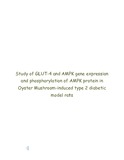Study of GLUT-4 and AMPK gene expression and phosphorylation of AMPK protein in Oyster Mushroom induced Type 2 diabetic model rats
Abstract
Type-2 diabetes mellitus is a complex and heterogeneous disorder which is depends upon insulin resistance and later insulin insufficiency and recognize by impaired insulin sensitivity as well as hyperglycemia, thus it represent one of the world leading causes of mortality and morbidity. So drug discovery and development have led to better ways to manage diabetes and its complications. GLUT-4 and AMPK gene has become the focus of the great deal of attention as a novel therapeutic target for the treatment of metabolic syndrome. Oyster Mushroom is traditionally used as remedy of diabetes and hypertension. The present study aims to observe the expression of GLUT-4 and AMPK gene and phosphorylation of AMPK proteins in insulin signaling pathway in STZ induced diabetic model rats through Oyster mushroom administration.STZ induced Type-2 diabetic model rats (Long-Evans) were used in this experiment.Rats were divided in two three groups:Diabetic control, Gliclazide treated rat and Mushroom treated rat.Mushroom was provided as feed supplement with 5% Oyster Mushroom powder. Glucose was measured using glucose oxidase method, lipid profile by enzymatic-colorimetric method, GLUT-4 & AMPK gene expression by rt-PCR methods and specific protein was identified using western blot and immunoprecipitation techniques. RNA extracted by TRIzol reagent and protein extracted by RIPA lysis buffer using different tissues. Fasting serum glucose level was 8.52±2.49 (mmol/L) in mushroom treated groups.On day 42 fasting serum glucose was 6.88±1.17 (mmol/L) and at day 56 it was 5.62 ± 2.02 (mmol/L) respectively.So serum glucose level was found to be decreased gradually but the decrease was non-statistically significant.The serum glucose level of water control diabetic rat on 42 day of also decreased non significantly. However, this low level of glucose did not persist for a longer period andon day 56 it was 4.66 ±1.78 mmol/L compared to 3.84 ±0.611mmol/L on day 42. In Gliclazide treated group fasting glucose concentration were 10.01±3.44, 10.48 ±2.66 and 6.70 ±2.82 on 0 day, 42 day and 56 day respectively. Mushroom treated rats increased total cholesterol level 63% at 42th day but at end of the experiment it became 32%. The standard drug Gliclazide treated group showed a decreased level of both triglyceride 37% and total cholesterol level 17% at the end of the study period.Water Diabetic control rats showed a 11% decrease in triglyceride level & a 42% increase in total cholesterol level on 56th day. The higher expression of genes (GLUT-4, AMPK,) for Mushroom treated rat tissues (Muscle, Adipose, Liver) was observed than non-diabetic rats, control diabetic rats but quit less than gliclazide treated rat.P-AMPK for muscle and
9
adipose tissue of diabetic control rats seems to be decreased compare to non-diabetic rats. But in case of mushroom treated diabetic rats, p-AMPK have increased compare to control rats. Besides, in case of adipose tissue, p-AMPK seems to decrease compare to non-diabetic rats. Mushroom treated rats has increased its p-AMPK protein better than the gliclazide treated rats. That means Oyster Mushroom can increases GLUT-4 and AMPK gene activity into the cell and thus contribute to reduce hyperglycemic state of type 2 diabetic model rats.

